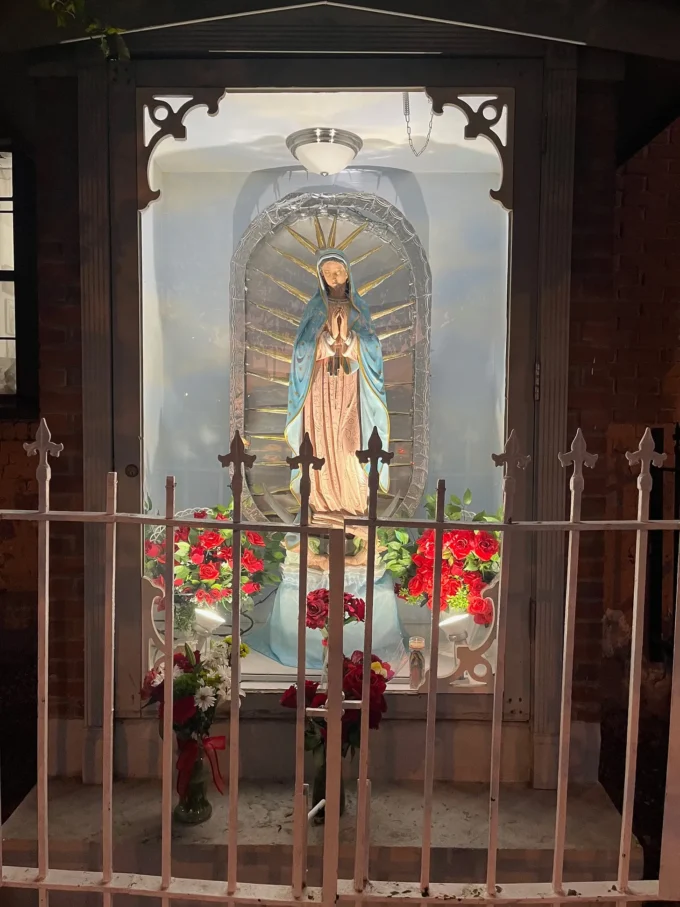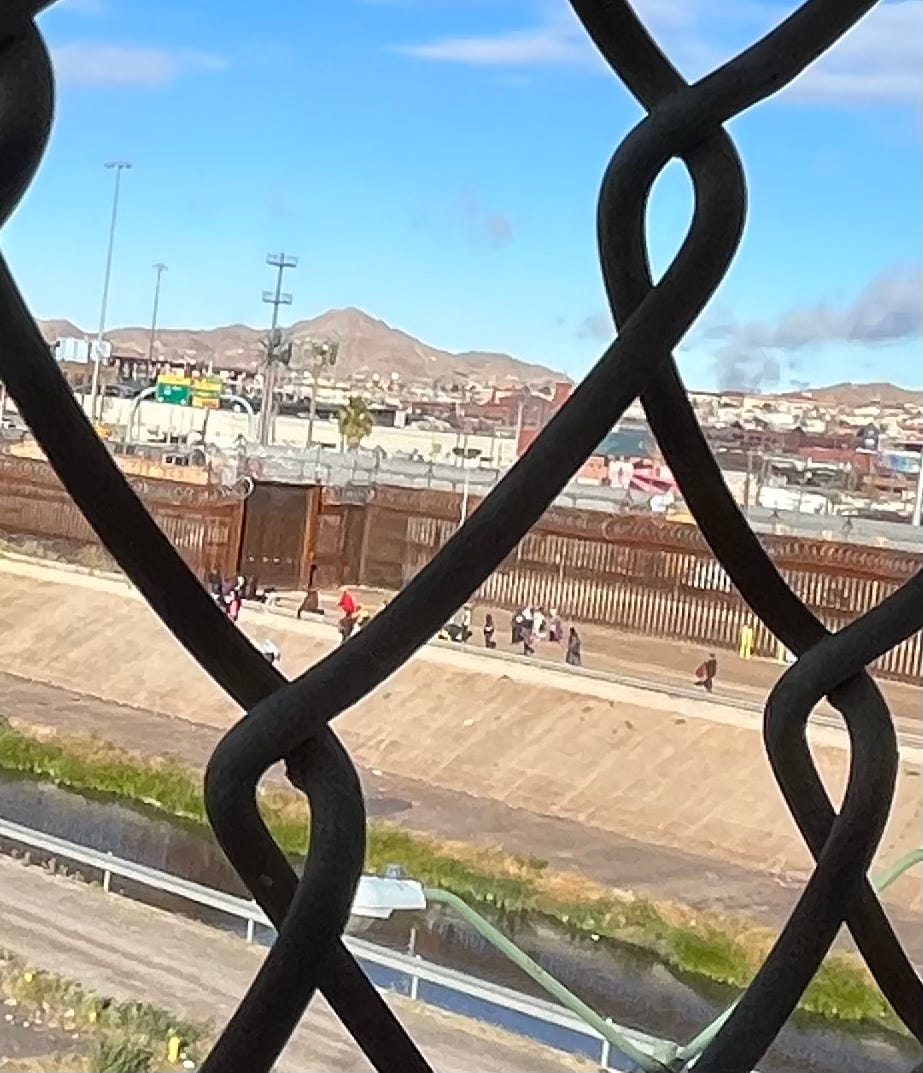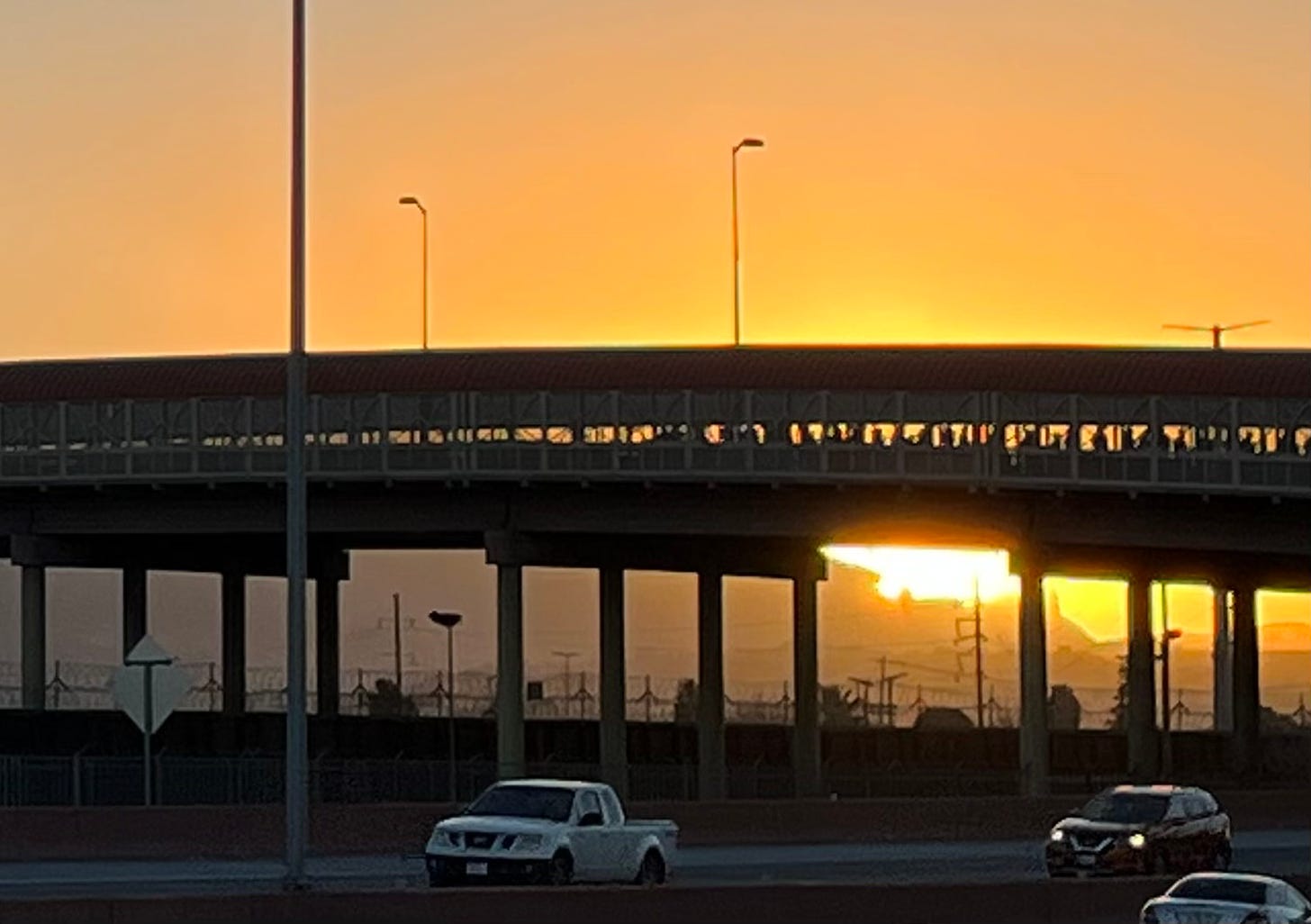

In front of the Sagrado Corazón church in El Paso, Texas, a few blocks from the border. Photo: Todd Miller.
I am at the Stanton Street Bridge between El Paso and Ciudad Juárez, where one year ago I watched groups of people wade through the shallow water to “pedir posada,” the Spanish-language term used for Joseph and Mary asking for refuge in Bethlehem 2,023 years ago. This year, there are no people below me, at least not right now, and the Rio Grande is a greenish, contaminated trickle that will dry up completely just east of El Paso, and then be replenished by the Rio Conchos 200 miles downriver in Presidio, Texas. On the other side of the bridge, you can see that the holiday season is in full gear as the line of people entering the United States coming from Ciudad Juárez extends up to the top of the bridge, exactly above the river. Surrounding the river are the props of the modern-day nativity scene: coiling razor wire, 30-foot walls, Texas Army National Guard troops and their armored jeeps, armed U.S. Border Patrol agents in their green-striped trucks, drone surveillance, camera surveillance, biometric systems. Partially, this is the result of the most money ever put toward federal border and immigration enforcement (as we reported this year, 2023 was $29.8 billion, a record number, which adds to the more than $400 billion since 2003). Partially, this is because Texas’s spending on Operation Lone Star, courtesy of Governor Greg Abbott and his right-wing, un-Christian justification machine, which has added up to $4.5 billion over the last two years. And this has been the response of the United States for people “pidiendo posada” for 30 years since Operation Blockade/Hold the Line began a border-building spree that has not ceased: there is no room at the inn.

From the Stanton Street Bridge between El Paso and Ciudad Juárez in December 2022 of people asking for refuge at the border wall. Photo: Todd Miller.
I think of that cold night on the ground in a stable that is depicted in so many places this time of year as I walk past shivering refugees in heavy coats sitting outside against the Sagrado Corazón church in El Paso a few blocks from the border. I am reminded of the hundreds upon hundreds of people arriving to the Arizona border, as Melissa reported on earlier this week. I am reminded of the young Guatemalan mother I met myself at the border wall in late November as she tended to her two-month-old under the 30-foot border wall. They had been waiting there for two days. The infant was sick, and the nights were cold. The rest of the group, from the coast of Guatemala, built a fire to keep warm. When were the wise men going to arrive, the kings, the angels? The humanitarians did arrive, as they do, day after day (see Melissa’s reporting on that). I am reminded of being in Bethlehem myself a few years back, visiting the Aida refugee camp of Palestinians, which was surrounded by a tall concrete wall that had an embedded “pill box,” or a tower where snipers could point their assault rifles located mere miles from that stable where Mary gave birth on the cold ground. The Christmas story is playing out all around us, as lawyer and anthropologist Petra Molnar pointed out for us just yesterday. Where Mary, Joseph, and the infant Jesus had to flee Bethlehem when King Herod started to wield authoritarian power, the long trek to Egypt fleeing persecution is happening right now, throughout the world, such as in the Darién Gap in Colombia and Panama, as discussed in Melissa’s two interviews with anthropologist Caitlyn Yates—one podcast in December, one in August. Or the equivalent might be in the Mediterranean, as we discussed with Lauren Markham last June after a ship capsized near Greece, killing 600 people, or the countless places across the world where people struggle with a huge enforcement apparatus, which Anna Lekas Miller wrote about in her book Love Across Borders. We have spent the year doing our best to give you insight into what is happening on our borders.
I love this time of year, December, because things start to slow down, the frenetic pace starts to wane. For me, this becomes a more reflective period. Yet this modern Christmas story is anything but reflective. On television sets, commercials remind us of the holiday spirit (and to buy as much as we can), and movies have heartwarming tales of people coming together. Yet hospitality is scoffed at in words and policy, no matter what president, no matter what political party. Melissa has reported time and time again about the dehumanizing rhetoric; earlier this week, she wrote about a Fox News reporter talking about invaders and invasions and “credible fear thresholds.” This discourse abounds, with stories of people “taking advantage of our asylum system,” and claims that the United States can’t absorb any more people. Did Mary and Joseph hear similar soundbites on their journeys?
In these stories, we rarely hear about U.S. foreign policy, both historical and current. Take, for example, the Monroe Doctrine’s effect in Latin America: the centuries of upholding dictatorships, training generals, arming militaries—and, lately, creating border guards—and influencing politics, as well as the economic domination, in which corporate power and extractive industries enjoy a borderless world and can travel anywhere and take anything they want (see NAFTA, see CAFTA), from precious resources to cheap labor. Meanwhile, regular people—sometimes the very people displaced by corporate power—face harsher and harsher border regimes that extend throughout the continent. The same thing the Greg Abbotts of the world accuse undocumented people of doing here, corporate power is doing there. Studies have continually shown how a migrant labor force bolsters the U.S. economy in myriad, even critical ways (see, for example, the film A Day without a Mexican), yet border crossers get blamed for the big societal problems as if they had the power to set policy in corporate board rooms and in Washington. In the halls of power, debates stagnate over whether people are refugees or economic migrants—creating more divisions between the people most affected by the entrenched borders.
At the height of her pregnancy, Mary and Joseph walked for days, fleeing a Caesar Augustus’s occupying force—a story that resonates with more than 184 million people on the move today. I am reminded of my dear friend Irene Morales, a nun with the Madres of the Eucaristia, who I worked with two decades ago and who told me day after day—as we traveled through northern Mexico and the U.S. borderlands—that she saw Christ in the faces of people on the move. In the early 2000s, thousands of people were arriving to Altar, Sonora, to cross through the Arizona deserts. The people I talked to and interviewed were mostly from southern Mexico, and in many cases they were migrating because they could no longer make ends meet. From about 2002 to 2005, I talked to hundreds of people, and often it was parents thinking about their children, parents who talked about skipping meals for their children, wanting their children to get an education, or sometimes it was children on the move for a sick parent. So often it was a story of sacrifice at a time in a post-9/11 era characterized by a massive ramp-up on the border, with terrorism and migration blurring into each other at a policy level. “El rostro de Cristo,” Irene told me.

Stanton Street Bridge at sunset with a long line of people crossing from Ciudad Juárez to El Paso as is typical during the holidays. Photo: Todd Miller.
As I stand on the bridge in Juárez, where everything seems basically the same, I know a lot has happened over the last year, and we have covered much of it at The Border Chronicle. I, for one, have been following that contaminated river and have gone into Chihuahua to report on border water struggles for a forthcoming book, and I have shared some photo essays here. Melissa also wrote about Chihuahua earlier this year for The New Yorker, focusing on the epidemic of journalists assassinated in Mexico, which she summarized in The Border Chronicle. I feel so fortunate to work alongside Melissa, who not only wrote (and talked to experts) about the innards of this massive border fortification, whether it be the surge of wall building, deadly vehicle chases, Operation Lone Star, or Florida cops patrolling the border—and the right-wing rhetoric that so often propels it (not to mention the Elon Musk circus)—but also about people in border communities for inspiration and solutions such as border artists, a brilliant sidewalk school, or a doctor who spends his time treating border crossers (Doctor Brian Elmore also penned an op-ed for us). And that’s just a taste. This year, I had the opportunity to go to Yale and debate border enforcement, a humbling and educational experience, to say the least. As I wrote about my losing effort, some of the dynamics we constantly struggle with in this sort of border journalism were clearly revealed.
Much has changed over the last year, but—from what I can tell suspended between El Paso and Ciudad Juárez—much has remained the same. The border policy is the same, there is more money in the budgets, there is more money in as-of-yet-unpassed supplemental funding bills, there are more and more contracts for private industry. And now we have an election year. And, as we all know, during an election year, the border is a politician’s sacrificial lamb. So be prepared for a good dose of border theater, and we’ll be here with our coverage, commentary, interviews, and podcasts. The last thing I want to do is stand on that bridge a year from now and watch people wade through the trickling Rio Grande to “pedir posada” at a large gate at an even more fortified border wall in El Paso. That is, however, the likely outcome of 2024, and we will cover all of it. But we will also find the spaces where people are trying to make change, we will listen to the border communities, and we will document the humanitarian efforts. And trust me you, we will be looking in the places where there is generosity toward the stranger.
This first appeared on The Border Chronicle. Subscribe here.
The post The Modern-Day Nativity Scene: A Concertina Wire Christmas appeared first on CounterPunch.org.
This content originally appeared on CounterPunch.org and was authored by Todd Miller.
Todd Miller | Radio Free (2023-12-25T07:05:04+00:00) The Modern-Day Nativity Scene: A Concertina Wire Christmas. Retrieved from https://www.radiofree.org/2023/12/25/the-modern-day-nativity-scene-a-concertina-wire-christmas/
Please log in to upload a file.
There are no updates yet.
Click the Upload button above to add an update.